A few decades ago, it was quite difficult to buy flowers in stores for the holidays. Very often, bouquets made by hand from field daisies, lilies of the valley, cornflowers, poppies, forget-me-nots and other lovely representatives of flora (shown in the photographs below) were presented for various celebrations.
What is the difference between a wildflower bouquet and a regular bouquet?
Today, flower boutiques and shops abound with flowers from huge greenhouses and foreign plantations. Specialized shops also offer wild flowers, which are very popular with many women of all ages. However, a bouquet collected and composed by yourself can please you more than a purchased one.
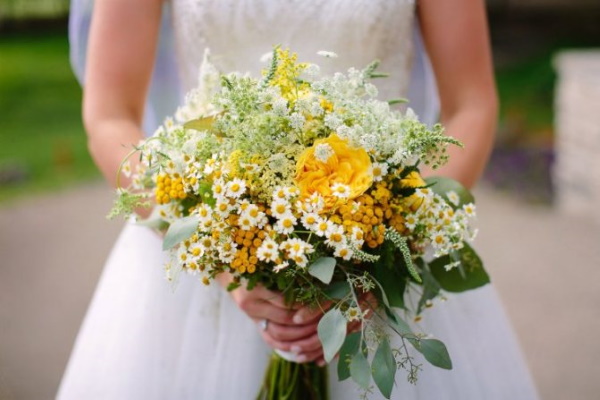
Bouquets of wild flowers (photos eloquently prove this) differ from the usual ones, composed of garden crops or purchased greenhouse species. Wild representatives of flora are smaller in size, and their coloring is a richer palette of shades. The aroma of flowers collected with your own hands in the bosom of nature is incomparable with the smell of pathos bouquets of glamorous roses or orchids. It is as if shrouded in a sunny haze, filled with warmth and tenderness.
Moreover, it is not at all necessary to have a special education as a florist in order to create a beautiful bouquet of wild flowers.
How to Properly Pick Wild Flowers
Despite the simplicity of collecting wild flowers and making bouquets from them, it is necessary to follow some tips and recommendations.
It follows:
- collect plants away from highways where there is a lot of dust and pollution;
- cut flowers with a knife or pruning shears (this way the stems will be less susceptible to mechanical damage);
- avoid unfamiliar representatives of flora (they may include poisonous plants or plants that are prohibited from being collected);
- first familiarize yourself with the list of wild flowers that can live in a cut state for a very short period of time;
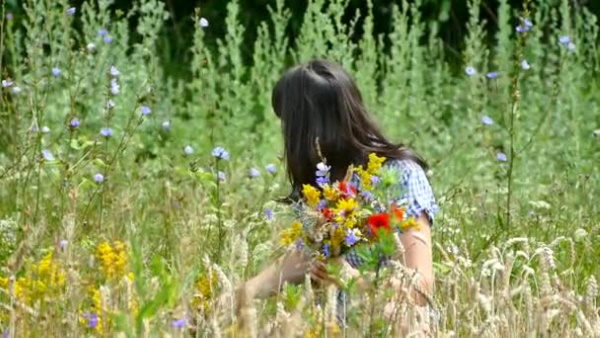
- give preference to those flowers that have small inflorescences and strong cores (these will last longer in a vase);
- cut flowers should be wrapped in a damp cloth or placed in a container with water to prevent them from wilting quickly during transportation to their destination;
- During collection, you can immediately remove the lower leaves and branches from the stems, as well as dried or unsightly parts (preparatory procedures make the subsequent process of making bouquets easier).
Flowers that can be used in a bouquet
Bouquets are made up of different wild herbs and flowers. In the photographs you can see beautiful mono-compositions, as well as fantasy combinations of various representatives of the rich flora. Before you start collecting flowers and making bouquets, you need to know which of them can be used and which cannot. It should be noted that in different regions the lists of "forbidden" flowers may differ.
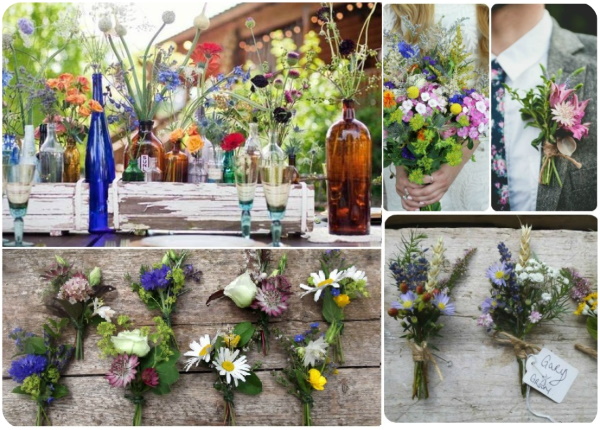
| Classification of colors | Flowers |
| Suitable for making bouquets | · Chamomile; · cornflower; · dandelion; · priest; · iris; Kermek (limonium); · bell; · red clover; · lupine; · sweet clover; · fireweed; · oregano; · elecampane; · goose onion; · Aquilegia; · delphinium; · yarrow; · Dzungarian aconite; · field poppy; · lavender; · California poppy; · medicinal burnet. |
| Are prohibited for collection ("Red Book") / the list is adjusted every 10 years | · Snowdrop;
· lily of the valley; · Colchicum merry; magnolia obovate; · Lady's slipper; · Sayan buttercup; · Scylla; · Adonis; · bellflower peach-leaved; · cut violet; · lily (saranka); · Orchis; · bathing suit; · field carnation; · Lotus nucifera; · serpukha; · Schrenk's tulip; · forget-me-not and others. |
| Having a short lifespan when cut | · Poppy (white, red);
· fireweed (Ivan tea); · bathing suit; · violet; · yellow buttercup; · marsh marigold. |
Shades of colors
Bouquets of wild flowers, photos of which vividly display their beauty and sophistication, differ from purchased garden and greenhouse crops in the variety of shades.
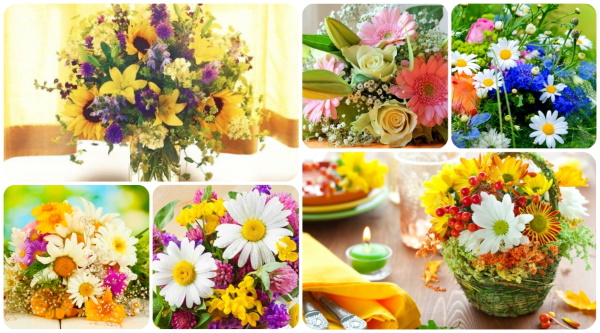
Incomparable in beauty:
- blue delicate forget-me-nots and periwinkle;
- snow-white daisies with yellow eyes at the center;
- scarlet delightful poppies;
- blue cornflowers and bells;
- sunny yellow dandelions;
- purple, white, pink irises and lupines;
- purple-pink oregano;
- white-yellow yarrow;
- pink, purple and white clover;
- yellow and white clusters of sweet clover;
- crimson, blue, yellow, purple, white or two-colored columbines;
- soft lilac and violet shades of lavender;

- dark red burnet;
- white, lilac, blue or yellow aconite;
- pale pink or white fireweed (Ivan-tea).
Number of colors
Wild flowers are good for their natural beauty and tenderness. Bouquets of them can contain a different number of flowers. In floristry, it is believed that a classic bouquet should have no more than 3 types of flowers. A field bouquet can perfectly combine a variety of crops and herbs. In addition, such bouquets often include ears of cereals, dried flowers, branches of conifers and legumes.
Type
Bouquets made of wild flowers and herbs can vary in height and shape. This depends on the preferences and taste of the person who creates them. Basic floristic techniques can be used.

In this case, bouquets can be:
- round; they are distinguished by their regular shape, dense arrangement and uniform inflorescences;
- cascading; they are arranged vertically on drooping stems, a frame or an artificial base;
- frame; natural materials (branches, vines, rods) and wire are used to create their base; the frame is complemented with various decorative details (feathers, sisal, rattan);
- non-standard shapes, which are created using various materials at hand: floral foam, glue, wire and paper.
Matching the style of the celebration
Bouquets of wild flowers (photo below) can be a wonderful addition and decoration for various holidays and special events. It should be noted that such bouquets are usually seasonal. Quite often, bouquets for the bride and boutonnieres for the groom at a wedding are made from delicate, cute flowers. In this case, they select crops that are loved by those for whom the flower arrangements are intended.
In addition, the style of clothing of the newlyweds, the style of the celebration being organized and the main color schemes in the decoration of the room for the celebration are taken into account.
The following combinations of wild flowers are used for the bride's bouquet:
- daisies of different types and sizes (chamomile, pyrethrum) and cornflowers;
- bells and daisies;
- delphiniums and white bells or daisies;
- dandelions and forget-me-nots;
- daisies and sunflowers;
- poppies with daisies and cornflowers or in a mono-bouquet.
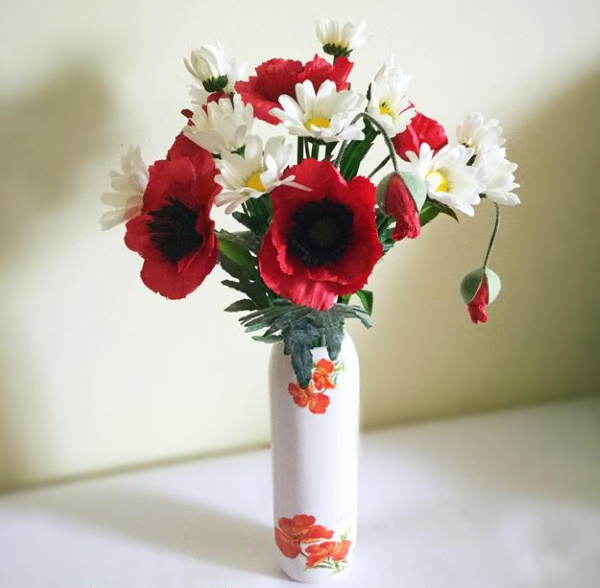
If bouquets of wild flowers are made for anniversaries, then the color schemes may differ depending on the gender of the person celebrating the anniversary. For women, preference is given to flowers of delicate pink, lilac, white shades in the design of the bouquet, and for men - blue, light blue, purple, yellow and red flowers.
For corporate events, small, strict bouquets are used, which combine flowers of one or three types in a discreet color scheme. They are placed in vases of laconic shapes or baskets, which are installed on special pedestals.
Master classes on making beautiful bouquets of wild flowers
One of the most important aspects of creating a bouquet of wild flowers is the selection of plants and materials.
It should be said that a good addition to such compositions can be:
- dried flowers;
- ears of cereal crops;
- feather grass panicles;
- conifer branches;
- burdock leaves;
- plantain;
- blueberry;
- greenery of ferns and daylilies;
- asparagus.

To create bouquets you may need:
- sharp scissors;
- pruning shears;
- nippers;
- oasis (special floral foam);
- florist's adhesive tape (elastic or paper);
- thin wire;
- twine;
- additional plant and decorative elements, which were mentioned above.
A simple bouquet of lupines, buttercups and rapeseed in a spiral technique
When collecting flowers for a bouquet, you need to have a container of water with you so that the plants are well saturated with moisture and can be used further in the work.
Tools and materials for bouquet design:
- branches of purple lupines, yellow buttercups and rapeseed;
- pruning shears;
- scissors;
- twine;
- decorative wide ribbon (tape).
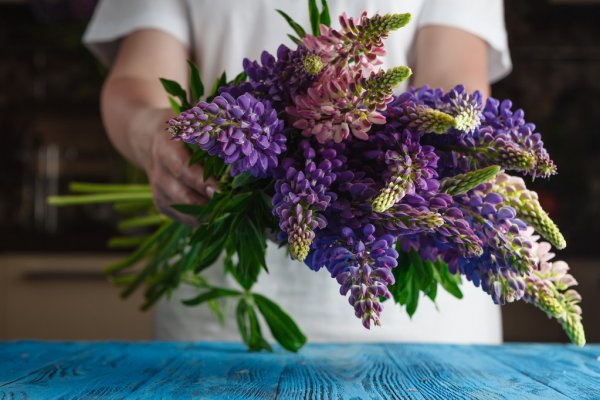
Work order:
- Strip the lower parts of the flower stems of leaves by ⅔ of the total length.
- Select a long branch of buttercup, attach another 1-2 branches of rapeseed to it at an angle, also at an angle.
- Place the lupine stem on top of the previously laid buttercup branches at an angle, gradually turning all the stems.
- Shorter stems of buttercup and rapeseed are placed lower (this gives the bouquet depth), and dark lupines are placed higher in the bouquet.
- When laying each subsequent branch, you should set an even greater angle of inclination (this gives a more spherical shape to the bouquet)
- Place all prepared stems at an angle.
- Inspect the resulting bouquet and, if necessary, correct any branches of flowers that are out of place in the composition.
- Tie the stems together with twine in a spiral at the junction.
- Trim all stems with pruning shears.
- Wrap the binding area with decorative tape cut at a 45 degree angle.
A simple, beautiful bouquet of purple and yellow wild flowers is ready.
Bouquet of wild daisies, veronica, solidago and tlaspi
To work you will need:
- branches of field daisies (matricaria);
- paniculate bright blue and light blue branches of veronica (snake grass);
- bright yellow fluffy branches of solidago (common goldenrod);
- white long inflorescences of field pennycress (field thlaspi);
- scissors and pruning shears;
- twine;
- decorative tape.
Work order:
- Remove leaves from plant stems.
- Place the longest stems of daisies and speedwells overlapping each other at an angle, gradually turning them in your hands.
- Next, gradually alternating, lay out yellow panicles of solidago and white inflorescences of tlaspi at an angle to decrease.
- By laying out all the flower stems one by one, it is necessary to achieve a spherical shape of the bouquet.
- Correct and trim branches and stems with pruning shears.
- Tie the bouquet with twine where the stems intersect.
- Wrap the bouquet with decorative ribbon over the garter.
A beautiful lush bouquet is ready.
Bouquet of tansy, cornflower and fern
To work you will need:
- cornflower flowers;
- branches of bright yellow tansy;
- branches of green fern;
- twine;
- scissors and pruning shears;
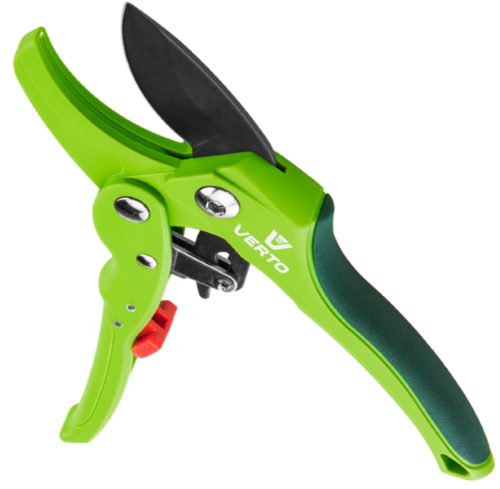
- decorative braid or ribbon.
Work order:
- Remove leaves from flower stems.
- Place 3 tansy branches at an angle, overlapping each other. They will determine the height of the bouquet.
- Next, lay out a few more rows of tansy in the same way, turning them in your hand.
- Then add sprigs of bright blue cornflower, alternating them with stems of tansy.
- The following stems are laid for shortening. The bouquet should be round and lush.
- Lastly, fern branches are woven into the bouquet. They are placed in the same way as the previous stems in a spiral and frame the entire bouquet.
- Tie the bouquet with twine where the stems intersect.
- Trim the branches to the correct length with pruning shears.
- Decorate the attachment point with ribbon.
A bright and unusual bouquet is ready.
How to make a bouquet in a basket
Bouquets of wild flowers (photo below in the text) in baskets can be presented as a gift or used as interior decoration. They look very gentle and colorful, no worse than exquisite pompous bouquets of expensive flowers. It should be remembered that the shape of the bouquet should match the shape of the basket.

To create a composition of wild daisies in a basket you will need:
- field daisies;
- gypsophila branches;
- small bush roses;
- oasis (floral sponge);
- a container with water to prepare the oasis;
- a round wicker basket of the required size;
- transparent cellophane;
- synthetic rope;
- scissors and pruning shears.
Work order:
- Prepare the flowers and branches of gypsophila by cutting them to the desired length at an acute angle.
- Cut the floral foam to the size of the basket.
- Place the finished oasis in a container on top of the water. You should wait until it is completely saturated with water on its own.
- Place cellophane film in the basket.
- Place the water-soaked oasis in the basket on the film.
- Trim off excess film.
- Secure the floral foam by threading the rope crosswise through the basket bars.
- Insert daisies all over the surface of the oasis at equal distances from each other. In the center they should stand vertically. In the direction from the center to the edges of the basket, the flowers are installed at an angle.
- Place roses separated from a single branch between the daisies.
- Place gypsophila branches along the edge of the oasis. They will hide the gaps between the edge of the basket and the flowers, and will also add tenderness and splendor to the bouquet.
Additional tips
In order for the bouquets and flower arrangements you create to delight you with their beauty and uniqueness, you should follow some rules and recommendations:
- Wild flowers for making bouquets should be collected in the morning or evening hours, avoiding doing this in hot weather in the sun.
- To collect flowers and transport them, you should stock up on a container of water or a large piece of damp cloth to wrap the cut plants.
- Flowers should not be picked. They should be cut with pruning shears at an acute angle. This will help the plants absorb moisture better.
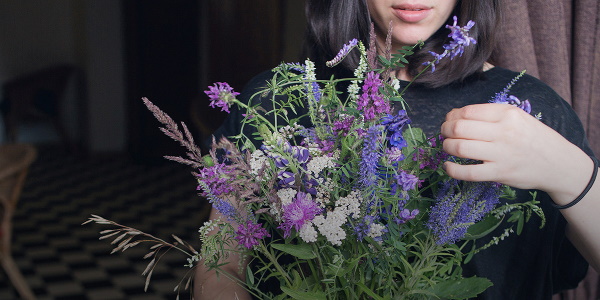
- You should not hold cut flowers in your hands. They will quickly fade from the living heat. It is better to wrap the stems in a bag or large torn leaves.
- When collecting wild flowers, it is better to immediately sort them by species and transport them separately, since some of them cannot live next to each other and accelerate the wilting process.
- Flowers and plants with hollow stems do not absorb water well. To preserve their presentable appearance, you can insert a piece of cotton wool into the hollow of the cut on the stem. This will provide greater moisture and saturation with moisture.
- The collected flowers and herbs should be cleared of leaves and thorns to avoid accelerating the putrefactive process in the bouquet, which will stand in a vessel with water.
- When preparing flowers for work, it is necessary to water them thoroughly.
- When working with an oasis (floristic sponge), you cannot move the flowers from one place to another several times. The holes in it will not be restored. A flower placed next to them will not hold.
- When placing flowers in a basket, you should always focus on the central point. It determines the entire arrangement of the composition.
- In the center, the flowers stand vertically. Closer to the edges, they should be given a horizontal position.
- When placing flowers in an oasis, remember that the length of the cut stem should have a reserve of 1.5 cm. It is to this depth that the flower will be inside the floral foam to receive moisture and nutrition.
- When decorating a basket with flowers, you should periodically turn it so that the composition is distributed evenly.
- To create bouquets of wild flowers, you should select vessels that match their size and design. The more lush the bouquet, the more modest the vase should be.
Beautifully and competently composed bouquets always please the eye. And wild flowers look touching in any composition, even in photographs. Although their lifespan outside of living nature is short, they can give many pleasant emotions, the smell of summer and a romantic mood.
Video about creating bouquets of wild flowers
Examples of bouquets of wild flowers:
